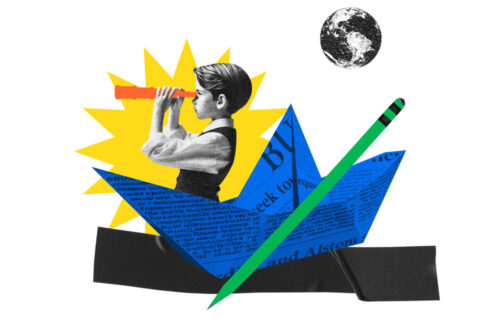Welcome to the future of design collaboration! In 2024, the design industry is undergoing a remarkable transformation, fueled by the power of teamwork and collaboration. Say goodbye to the days of the solitary artist toiling away in isolation; it’s time to embrace the collective genius of collaborative design.
Picture this: you and your fellow designers, each bringing your unique perspectives and talents to the table, joining forces to create innovative, boundary-pushing designs. It’s a symphony of creativity, where ideas bounce off one another, sparking inspiration and taking your work to unimaginable heights.
With the rise of visual collaboration platforms and advancements in AI technology, the possibilities for collaborative teamwork are endless. These platforms harness the power of AI to automate routine tasks, generate fresh ideas, and accelerate the learning process. Together, you and your team can accomplish more in less time, pushing the boundaries of design and innovation.
Design collaboration is no longer a luxury; it’s a necessity in today’s fast-paced, interconnected world. By embracing collaborative teamwork, you unlock a world of possibilities, where you can tap into the collective brilliance of like-minded individuals and create something truly extraordinary.
So, whether you’re a seasoned designer looking to nurture your creativity or a rookie eager to learn from the best, dive into the world of design collaboration in 2024. Together, let’s revolutionize the way we work, unleash our creative potential, and shape the future of design.
Building with AI
In the world of design collaboration, AI is becoming an indispensable tool in 2024. With its ability to enhance collaboration, innovation, learning, and decision-making, visual collaboration platforms are increasingly leveraging AI to elevate the design process. These platforms are revolutionizing the way designers work by leveraging AI-generated ideas and enabling AI-powered decision-making.
Imagine a world where the creative process is accelerated and ideas flow effortlessly. Thanks to AI, that world is within reach. Visual collaboration platforms are now equipped with AI-powered algorithms that can generate a multitude of design ideas, providing designers with a springboard for creativity. These AI-generated ideas not only inspire designers but also streamline the flow of information, making collaboration smoother and more efficient.
Visual collaboration platforms are embracing AI to enhance the design collaboration experience and make it more efficient and effective.
But AI’s impact goes beyond idea generation. It also plays a crucial role in decision-making. With its ability to analyze vast amounts of data and patterns, AI can inform tactical decisions, helping designers make more informed choices. By recommending the best course of action based on data-driven insights, AI-powered decision-making brings a new level of efficiency and effectiveness to the design collaboration process.
Visual collaboration platforms are at the forefront of this AI revolution, constantly pushing the boundaries of what is possible. By integrating AI into their core functionality, these platforms empower designers to collaborate more seamlessly and produce exceptional results. Whether it’s through generating ideas or informing decisions, AI is transforming the way designers work and pushing the boundaries of design collaboration.
AI in Action
To illustrate the power of AI in design collaboration, let’s take a look at a hypothetical scenario:
- A team of designers is working on a new website design project using a visual collaboration platform.
- They start by brainstorming ideas, and the AI algorithms in the platform generate a diverse range of design concepts based on their input.
- The team reviews the AI-generated ideas and selects a few that stand out.
- With the help of AI-powered decision-making, the platform analyzes user data and recommends design elements that are likely to resonate with the target audience.
- The designers make informed decisions based on the AI insights, refining their initial ideas and optimizing the design.
- Throughout the collaboration process, the AI algorithms continue to learn and adapt, providing real-time feedback and suggestions.
- The final design is a result of the seamless collaboration between the designers and AI, combining creative ideation with data-driven insights.
This scenario demonstrates how AI elevates design collaboration by enhancing creativity, streamlining decision-making, and enabling designers to create exceptional designs. It exemplifies the power of AI and visual collaboration platforms in shaping the future of design collaboration.
| Benefits of AI in Design Collaboration | Examples |
|---|---|
| Accelerated creativity: AI-generated ideas inspire designers and streamline the flow of information. | AI algorithms generate a variety of design concepts based on user input, sparking new ideas and saving time. |
| Informed decision-making: AI-powered analytics provide designers with data-driven insights for making tactical decisions. | AI analyzes user data to recommend design elements that are likely to resonate with the target audience. |
| Seamless collaboration: AI algorithms continuously learn and adapt, providing real-time feedback and suggestions throughout the collaboration process. | AI algorithms learn from user interactions and adapt to provide personalized suggestions and feedback. |
Supporting a Spectrum of Collaboration
The way we work is evolving, with hybrid work and remote work becoming more prevalent. In 2024, visual collaboration platforms are adapting to support a spectrum of collaboration models. These platforms aim to create cohesive and central spaces that unite team members across different locations and working styles.
It’s not just about remote or hybrid work anymore; it’s about accommodating diverse working models. Visual collaboration platforms have been adding features to promote collaboration equity and enable asynchronous collaboration, ensuring that all voices are heard, regardless of time zone or location.
Stay Connected, Stay Creative
With the rise of hybrid and remote work, visual collaboration platforms play a crucial role in bridging the gap between team members. Here are some key features that these platforms offer to enhance collaboration across diverse work models:
- Real-time Communication: Video conferencing, instant messaging, and live commenting enable seamless communication and collaboration, fostering a sense of connectedness regardless of geographical locations.
- Project Management: Centralized project boards, task tracking, and shared calendars help teams stay organized and manage projects more efficiently, ensuring everyone is on the same page.
- Virtual Whiteboards: Digital whiteboards allow teams to brainstorm, sketch ideas, and visualize concepts collaboratively, promoting creativity and capturing collective insights.
Quote: “Visual collaboration platforms have become the glue that holds diverse teams together, enabling seamless communication, enhancing productivity, and nurturing creative collaboration.” – Jane Johnson, CEO of CreativeWorkplace Inc.
Visual collaboration platforms also enable asynchronous collaboration, where team members can work at their own pace and contribute ideas and feedback without the constraints of real-time interaction. This flexibility accommodates different work styles and time zones, ensuring that collaboration doesn’t have to be limited by geographical boundaries.
By supporting a spectrum of collaboration models, visual collaboration platforms empower teams to embrace hybrid work and remote work while maintaining productivity and fostering strong collaboration. As we move towards the future of work, these platforms will continue to evolve, creating inclusive and efficient virtual workspaces.
Comparison of Collaboration Models
| Collaboration Model | Definition | Key Characteristics |
|---|---|---|
| Traditional Office | In-person collaboration within a physical office space | Face-to-face interaction, immediate feedback, limited flexibility |
| Hybrid Work | Combination of remote work and in-person work | Flexibility, remote collaboration, partial in-person interaction |
| Remote Work | Working outside a traditional office, usually from home or any location | Location flexibility, digital collaboration, asynchronous communication |
Prioritizing Collaboration Equity
Collaboration equity is a vital aspect of the evolving design industry in 2024. Visual collaboration platforms are revolutionizing workspaces to create inclusive environments where everyone’s voice is valued. Inclusive workspaces foster a sense of belonging and enable diverse perspectives to flourish.
To prioritize collaboration equity, visual collaboration platforms have developed a range of innovative tools and features. One such tool is Visual Activities, which promotes equal participation and engagement among team members. Through Visual Activities, teams can collectively brainstorm, prioritize ideas, plan projects, vote on decisions, and foster collaborative decision-making. These tools empower each individual to contribute their unique insights and expertise, fostering a more equitable and inclusive work environment.
“Collaboration equity is about harnessing the power of diverse voices, experiences, and perspectives in the design process to drive innovation and creativity.” – Jane Smith, Design Lead at CollaborateCo
Collaboration Equity in Action
To further illustrate the significance of collaboration equity, let’s look at a hypothetical example:
| Traditional Workspace | Inclusive Workspace |
|---|---|
| Team meetings dominated by a few outspoken individuals. | All team members actively participate and contribute their ideas. |
| Decisions made without considering all perspectives. | Decisions are collectively made, taking into account diverse viewpoints. |
| Remote team members feel disconnected and left out. | Remote team members are fully engaged and included in the collaboration process. |
As the table illustrates, prioritizing collaboration equity enables inclusive workspaces where all team members feel valued, heard, and empowered to contribute. This approach fosters a culture of mutual respect and appreciation, driving greater innovation and productivity.
By leveraging visual collaboration platforms and incorporating equity-focused tools, organizations can cultivate an environment where collaboration is not limited by physical location or working style. The future of work lies in creating inclusive spaces that leverage the power of diverse voices and perspectives to drive collaborative success.
By prioritizing collaboration equity and embracing inclusive workspaces, visual collaboration platforms are transforming the way teams collaborate and innovate. Empowering all team members to contribute and be heard results in more diverse and impactful outcomes. In the dynamic landscape of 2024, collaboration equity is the cornerstone of building successful and inclusive design teams.
Conclusion
In 2024, the future of work is characterized by the exciting possibilities of design collaboration. With the industry’s increasing reliance on technology, design teams are embracing visual collaboration trends to create innovative and immersive experiences. This shift is not only transforming the design process but also shaping the way we work and collaborate.
Visual collaboration platforms are at the forefront of this transformation, leveraging AI and other advancements to facilitate collaborative workspaces. By integrating AI into the design collaboration process, these platforms enable teams to generate ideas, streamline information flow, and make informed decisions more efficiently than ever before.
The evolution of work models also plays a significant role in design collaboration in 2024. As hybrid and remote work become more prevalent, visual collaboration platforms are adapting to support a spectrum of collaboration models. These platforms focus on fostering collaboration equity, ensuring that all team members, regardless of their location or working style, have an equal voice.
As designers and teams navigate the ever-changing landscape of design collaboration, embracing these trends and leveraging the power of visual collaboration is essential. By embracing technology, accommodating diverse work models, and prioritizing collaboration equity, designers can unlock new levels of creativity, innovation, and productivity in their work. The future of design collaboration is bright, and it’s up to you to seize the opportunities that lie ahead.
FAQ
How is AI revolutionizing the design collaboration process?
AI is automating routine tasks, generating ideas, summarizing information, and accelerating learning in the design collaboration process. It enhances creativity, innovation, and decision-making.
How do visual collaboration platforms support different collaboration models?
Visual collaboration platforms adapt to hybrid and remote work, accommodating diverse working models. They create cohesive and central spaces for team members across different locations and working styles.
What is collaboration equity in design collaboration?
Collaboration equity refers to the creation of inclusive workspaces where everyone has an equal voice. Visual collaboration platforms promote collaboration equity by providing tools that engage all team members in brainstorming, prioritizing, planning, voting, and decision-making.
How are visual collaboration platforms shaping the future of work?
Visual collaboration platforms leverage AI, accommodate hybrid and remote work, and promote collaboration equity to revolutionize the design process. These trends foster collaboration, innovation, and creativity while creating immersive and interactive experiences.



